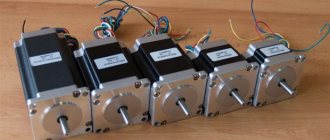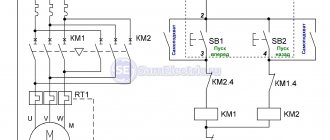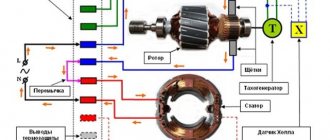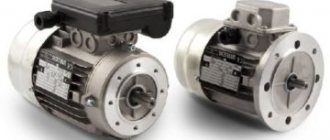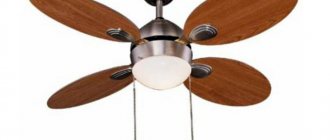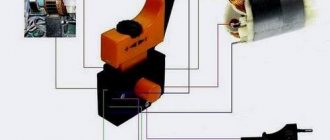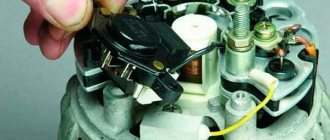Motors have been used for many years to convert electrical energy into various types of mechanical energy. This feature determines its high popularity: processing machines, conveyors, some household appliances - electric motors of various types and power, overall dimensions are used everywhere.
Basic performance indicators determine what type of design the engine has. There are several varieties, some are popular, others do not justify the complexity of connection and high cost.
A permanent magnet motor is used less frequently than an asynchronous version. In order to evaluate the capabilities of this design option, you should consider design features, performance characteristics and much more.
What is a magnetic motor
In the scientific world, perpetual motion machines are divided into two groups: the first and second types.
And if with the first everything is relatively clear - this is rather an element of fantastic works, then the second is very real. Let's start with the fact that the first type of engine is a kind of utopian thing capable of extracting energy from nothing. But the second type is based on very real things. This is an attempt to extract and use the energy of everything that surrounds us: the sun, water, wind and, of course, the magnetic field. Many scientists from different countries and in different eras tried not only to explain the possibilities of magnetic fields, but also to implement some kind of perpetual motion machine powered by these very fields. The interesting thing is that many of them have achieved quite impressive results in this area. Names such as Nikola Tesla, Vasily Shkondin, Nikolai Lazarev are well known not only in a narrow circle of specialists and adherents of the creation of a perpetual motion machine.
Of particular interest to them were permanent magnets capable of renewing energy from the world's ether. Of course, no one on Earth has yet been able to prove anything significant, but thanks to studying the nature of permanent magnets, humanity has a real chance to get closer to using a colossal source of energy in the form of permanent magnets.
And although the magnetic topic is still far from being fully studied, there are many inventions, theories and scientifically based hypotheses regarding perpetual motion. At the same time, there are many impressive devices passed off as such. The magnet engine itself already exists, although not in the form in which we would like, because after some time the magnets still lose their magnetic properties. But, despite the laws of physics, scientists were able to create something reliable that works using the energy generated by magnetic fields.
Today there are several types of linear motors that differ in their structure and technology, but operate on the same principles . These include:
- Operating solely due to the action of magnetic fields, without control devices and without external energy consumption;
- Pulse action, which already have both control devices and an additional power source;
- Devices that combine the operating principles of both engines.
Some historical facts
The first attempt to construct a magnetic perpetual motion machine was made in the middle of the last century. The year 1969 was a turning point for this direction of scientific thought: a fully operational motor was presented to the public, the cycle of which was finite, but significantly different from other models in the duration of action. The justification for this was the weak magnets involved in the design and the high friction force, which extinguished the useful energy of the device.
Deciding to bask in the rays of capricious glory on the wave of general enthusiasm, specialist Michael Brady from Africa managed to design a working 6 kW engine. To dispel any doubts about his ingenuity and ingenuity, he made a video about his own alternative Perendeva engine and posted it on the Internet, where millions of YouTube users were able to see the development. Either they were intoxicated by what they saw and gave free rein to their dreams, or the inventor was able to skillfully deceive the audience, but the development was a dizzying success.
Taking this opportunity, Brady initiated a fundraiser for the production of Perendev generator sets of 100 and 300 kW, which would be enough for the uninterrupted operation of large-scale production. A million dollars is not bad for a startup, even if it’s just another soap bubble. With an impressive sum, the savvy engineer managed to move to Switzerland and declared himself bankrupt in order to spend the rest of his days in luxury and a comfortable life. However, soon a criminal trial was launched against the would-be inventor, where the word “fraudster” was said to the main character. Until now, its discovery excites inquiring minds, and attempts to create a Perendev engine using magnets are actively discussed on thematic forums.
Myth or reality?
Perpetual motion is familiar to almost everyone from school, only in physics lessons it was clearly stated that it is impossible to achieve practical implementation due to friction forces in moving elements. Among the modern developments of magnetic motors, self-supporting models are presented, in which the magnetic flux independently creates a rotational force and continues to support itself throughout the entire operation process. But the main stumbling block is the efficiency of any motor, including magnetic, since it never reaches 100%. Over time, the engine will still stop.
Therefore, all practical models require repeated intervention after a certain time or some third-party elements operating from an independent power source. The most likely option for fuel-free engines and generators is a magnetic machine. In which the main driving force will be the magnetic interaction between permanent magnets, electromagnetic fields or ferromagnetic materials.
A current example of implementation is decorative decorations made in the form of constantly moving balls, frames or other structures. But for them to work, it is necessary to use batteries that supply direct current to the electromagnets. Therefore, next we will consider the principle of action that gives the most encouraging expectations.
Other designs
There are many other designs, including workable ones, but they are built according to the above schemes. Electromagnetic-type motor-generators are gaining immense popularity among enthusiasts, and some designs have already been introduced into serial production. But these are, as a rule, the simplest mechanisms. Electric bicycles have recently often used a motor-wheel designed by Shkondin. But for normal operation of any electromagnetic motor, there must be a source of energy. Even an electromagnetic solenoid motor will not be able to operate without additional power.
Such mechanisms cannot do without a battery. It is necessary to energize the electromagnet winding in order to create a field and spin the rotor to the minimum frequency. In essence, the result is an electromagnetic DC motor that is capable of energy recovery. In other words, the motor only works when accelerating, and when braking it switches to generator mode. Any electric car that can be found on sale has these features. Some simply do not have a braking system as such; the functions of the pads are performed by engines operating in generator mode. The greater the load on the winding, the stronger the reaction force will be.
Design and principle of operation
Today there are quite a large number of magnetic motors, some of them are similar, others have a fundamentally different design.
For example, we will consider the most obvious option:
Operating principle of a magnetic motor
As you can see in the figure, the motor consists of the following components:
- There is only one stator magnet and it is located on a spring pendulum, but such placement is required only for experimental purposes. If the weight of the rotor turns out to be sufficient, then the inertia of movement will be enough to overcome the smallest distance between the magnets and the stator can have a stationary magnet without a pendulum.
- Disc-type rotor made of non-magnetic material.
- Permanent magnets mounted on a snail-shaped rotor in the same position.
- Ballast is any weighty object that will provide the necessary inertia (in working models, this function can be performed by a load).
All that is needed for the operation of such a unit is to move the stator magnet a sufficient distance to the rotor at the point of greatest distance, as shown in the figure. After this, the magnets will begin to attract as the snail shape approaches in a circle, and the rotor will begin to rotate. The smaller the size of the magnets and the smoother the shape, the easier the movement will occur. At the point of maximum approach, a “dog” is installed on the disk, which will shift the pendulum from its normal position so that the magnets are not attracted to a static position.
Stepper motors
Linear stepper motors convert a sequence of electrical signals not into rotational, but into linear linear motion. They are used in technologies that require moving objects in a plane. These could be engines for CNC machines or plotters for modern computers. The use of a linear stepper motor simplifies the kinematic circuit of the electric drive.
The flat stator is made of soft magnetic material. Permanent magnets are installed to bias the magnetic circuits. The LD armature moves in accordance with a principle similar to a rotation motor only in a straight direction. For this purpose, teeth of equal sizes are made on the plane of the movable and fixed parts. Within one section of the runner of a linear stepper motor, the teeth are offset by half their width t/2, and in the second section by a quarter t/4. In this case, regardless of the location of the runner providing the magnetization process, the magnetic resistance will remain the same.
Linear stepper motors between the stator and the moving part have a minimum magnetic-air gap through which interaction occurs. At the same time, there is virtually no resistance to movement, as a result, the linear stepper motor provides high-precision positioning.
The traditional linear actuator is a linear DC motor made on the basis of commutator motors. In such devices, rotation is converted into linear motion by means of a gearbox, nut and long screw connected to the output shaft. Due to the fact that such a design is not capable of ensuring the accuracy of movement or the required speed parameters, an electric drive with a stepper rotation motor is used, in which, instead of a standard shaft, one of the following designs is implemented:
- extended shaft with external nut;
- retractable rod
- hollow shaft with internal nut.
The linear stepper motor or actuator of the first type has in its design an elongated shaft with a thread applied to it and a nut that moves progressively along the shaft. In this case, the nut itself is stationary. The length of the screw shaft corresponds to the stroke length.
In the second case, a linear stepper motor provides linear motion through a retractable rod and a threaded output shaft connected to it. The external load is applied directly to the rod.
The version of the hollow central part with an internal nut provides for the installation of a lead screw. The latter, as the nut rotates, moves parallel to its axis and can exit on both sides of the electric motor.
Linear stepper motors in the form of actuators are designed to build systems with translational movement of objects at low speed and high accuracy when working in limited work spaces.
Modern classification of perpetual motion machines
- A perpetual motion machine of the first kind
is an engine (an imaginary machine) capable of endlessly doing work without consuming fuel or other energy resources. Their existence contradicts the first law of thermodynamics. According to the law of conservation of energy, all attempts to create such an engine are doomed to failure. - A perpetual motion machine of the second kind
is an imaginary machine that, when put into motion, would transform into work all the heat extracted from surrounding bodies (see Maxwell's Demon). They contradict the second law of thermodynamics. According to the Second Law of Thermodynamics, all attempts to create such an engine are doomed to failure.
Types of permanent magnets
To stop the engine, the solenoid valve must be powered from a powerful source. Or you can use strong magnets. Therefore, it is advisable to use such designs on powerful equipment. And to make your own motor-generator, it is advisable to use ferrite or neodymium magnets. Characteristics of permanent magnets:
- Ferrite-barium: induction in the air gap at the level of 0.2-0.4 T; energy product 10-30 kJ/cu. m; coercive force 130-200 kA/m. Cost from 100 to 400 rubles. per kilogram. Operating temperature no more than 250 degrees.
- Ferrite-strontium: induction in the air gap at the level of 0.35-0.4 T; energy product 20-30 kJ/cu. m; coercive force 230-250 kA/m. Cost from 100 to 400 rubles. per kilogram. Operating temperature no more than 250 degrees.
- Neodymium magnets: induction in the air gap at the level of 0.8-1.4 T; energy product 200-400 kJ/cubic. m; coercive force 600-1200 kA/m. Cost from 2000 to 3000 rubles. per kilogram. Operating temperature no more than 200 degrees.
Barium permanent magnets are half the price of neodymium ones. But the dimensions of generators based on such magnets are much larger. For this reason, it is best to use neodymium magnets in homemade electromagnetic motors. An engine with an electromagnetic brake made from such materials will be able to recover much more energy when stopping.
The history of the perpetual motion machine
The first mention of the creation of such a device appeared in India in the 7th century, but the first practical attempts to create it appeared in the 8th century in Europe. Naturally, the creation of such a device would significantly accelerate the development of energy science.
In those days, such a power unit could not only lift various loads, but also turn mills, as well as water pumps. In the 20th century, a significant discovery occurred, which gave impetus to the creation of a power unit - the discovery of a permanent magnet with the subsequent study of its capabilities.
The motor model based on it was supposed to work for an unlimited amount of time, which is why it was called eternal. But be that as it may, nothing lasts forever, since any part or detail can malfunction, therefore, the word “eternally” must only be understood as meaning that it must work without interruption, without implying any costs, including fuel.
Now it is impossible to accurately determine the creator of the first perpetual mechanism, which was based on magnets. Naturally, it is very different from the modern one, but there are some opinions that the first mention of a power unit using magnets is in the treatise of Bhskara Acharya, a mathematician from India.
The first information about the appearance of such a device in Europe appeared in the 13th century. The information came from Villard d'Honnecourt, an eminent engineer and architect. After his death, the inventor left his notebook to his descendants, which contained various drawings of not only structures, but also mechanisms for lifting loads and the actual first device using magnets, which vaguely resembles a perpetual motion machine.
Internal combustion engines
This type of motor is fundamentally different from a classic electric drive, for example, such as an asynchronous linear motor, since it has a fundamentally different device and method of operation. Essentially it is an internal combustion engine, but without the complex and cumbersome crank mechanism. These types of linear motors have a dead (stationary) closed circuit, in the volume of which one or two pistons move rectilinearly. The free movement of the piston device is ensured by the compressed air flow located in adjacent containers, the spring element and the mass of the piston itself.
Linear internal combustion engines have a simpler design compared to the traditional version with a crank system. They are more balanced, durable, and compact in size. Electric generators and diesel hammers are made on the basis of drives of this type. A significant disadvantage of free-piston units is the difficult start-up and control of a linear motor. This is due to the absence of any rigid connections in the drive mechanism
In most cases, the installation is started using compressed air. At the same time, thanks to the development of microprocessor technologies, experiments are being carried out in terms of electronic start-up and process control. These methods are:
- the use of an electric generator that is connected to a piston device;
- the use of pressure sensors, motion sensors and other means to control the injection and ignition of the fuel mixture supplied inside;
- electrical circuit with the installation of such an element as an electromagnetic valve, placed at the inlet and outlet of the mixture to clearly control its volume.
Considering the promise of the new direction, many enthusiasts perform calculations of the linear mechanism, after which they create models of electric generator machines with their own means and their own hands. For this purpose, the cylinders are glass tubes, the pistons are graphite bosses, and the source of the spark is the circuit board of a household device for igniting a gas stove. If desired, you can create a small motor and successfully use it as an autonomous source of electricity. It must be taken into account that when using permanent magnets, a sufficient cooling system must be organized. This is due to the fact that magnetic elements tend to demagnetize when they reach a certain temperature level.
Real prospects for creating a perpetual motion machine using magnets
Opponents of the theory of creating a perpetual motion machine say that it is impossible to violate the law of conservation of energy. Indeed, there are absolutely no prerequisites for obtaining energy from nothing. On the other hand, a magnetic field is not emptiness at all, but a special type of matter, the density of which can reach 280 kJ/m³. It is this value that is the potential energy that a perpetual motion machine on permanent magnets can theoretically use. Despite the lack of ready-made samples in the public domain, numerous patents indicate the possibility of the existence of such devices, as well as the fact of the presence of promising developments that have remained classified since Soviet times.
Norwegian artist Reidar Finsrud created his own version of a perpetual motion machine using magnets. Famous physicists and scientists contributed to the creation of such electric generators: Nikola Tesla, Minato, Vasily Shkondin, Howard Johnson and Nikolai Lazarev. It should be noted right away that engines created with the help of magnets are called “eternal” conventionally - the magnet loses its properties after a couple of hundred years, and along with it the generator will stop working.
The principle of operation of a perpetual magnetic mover
Most modern electric engines use the principle of electrical transformation. current into the mechanical rotation of the rotor, and with it the drive shaft. This means that any calculation will show an efficiency of less than 100%, and the unit itself is dependent and not autonomous. The same situation is observed in the case of a generating device. Here, the moment of rotation of the shaft, which occurs due to thermal, nuclear, kinetic or potential energy of the movement of the medium, leads to the generation of electric current on the collector plates.
A permanent magnet motor uses a completely different approach to operation, which eliminates or minimizes the need for third-party energy sources. The operating principle of such an engine can be described using the example of a “squirrel wheel”. No special drawings or reliability calculations are required to produce a demonstration model. It is necessary to take one permanent magnet of the dish (disk) type, the poles of which are located on the upper and lower planes of the plates. It will serve as the basis of the structure, to which you need to add two ring barriers (internal, external) made of non-magnetic shielding materials. A steel ball is placed in the gap (track) between them, which will act as a rotor. Due to the properties of the magnetic field, it will immediately stick to the disk with an opposite pole, the position of which will not change during movement.
The stator is a conventional plate made of shielded material, onto which permanent magnets, for example, neodymium, are attached along a circular path. Their poles are located perpendicular to the poles of the disk magnet and rotor. As a result, when the stator approaches the rotor at a certain distance, an alternating attraction and repulsion occurs in the magnetic field, which forms a moment and then develops into rotation of the ball along a circular path (track). Starting and stopping occur due to the approach or distance of the stator with magnets. This perpetual motion machine on permanent magnets will work until they are demagnetized. The calculation is carried out regarding the size of the corridor, the diameters of the ball, stator plate, as well as the control circuit on relays or inductors.
Based on a similar principle of operation, many models of operating samples have been developed, for example, synchronous motors and generators. The most famous among them are Tesla, Minato, Perendev, Howard Johnson, Lazarev magnetic thrust engines, as well as linear, unipolar, rotary, cylinder, etc.
Let's look at each of the examples in more detail.
The most famous analogues of perpetual motion magnets
Numerous enthusiasts are trying to create a perpetual motion machine using magnets with their own hands according to a scheme in which rotational motion is ensured by the interaction of magnetic fields. As you know, poles of the same name repel each other. It is this effect that underlies almost all such developments. Proper use of the energy of repulsion of like poles of a magnet and attraction of unlike poles in a closed loop allows for long-term non-stop rotation of the installation without the application of external force.
Howard Johnson Magnetic Motor
Howard Johnson Magnetic Motor
In his work and the subsequent patent for the invention, Howard Johnson used the energy generated by the flow of unpaired electrons present in magnets to power the motor circuit. The Johnson stator is a collection of many magnets, the location and movement of which will depend on the structural layout of the Howard Johnson unit (linear or rotary). They are fixed on a special plate with a high degree of magnetic permeability. The same poles of the stator magnets are directed towards the rotor. This ensures alternate attraction and repulsion of the poles, and with them, the moment and physical displacement of the stator and rotor elements relative to each other.
The calculation of the air gap between them, organized by Howard Johnson, makes it possible to adjust the magnetic concentration and interaction force up or down.
Types of magnetic motors and their circuits
Today there are many models of fuel-free generators, electrical machines and motors, whose operating principle is based on the natural properties of permanent magnets. Some options were designed by eminent scientists, whose achievements became the founding stone in the foundation of science. Therefore, next we will consider the most popular of them.
Magnetic unipolar Tesla motor
An outstanding scientist who at one time became a pioneer in the field of electrical supply. current, asynchronous electric motors on alternating current, did not deprive his attention and calculations of the issue of an eternal source of energy. In the scientific community, this invention is referred to differently as the Tesla unipolar generator.
Initially, the calculation of this type of device was carried out by Faraday, but its prototype, with a similar principle of operation, did not have the proper efficiency and stability of operation, that is, it did not achieve the goal. The term “unipolar” means that in the circuit of the unit, a ring, disk (plate) or cylinder conductor is located in a circuit between the poles of a permanent magnet.
Tesla magnetic motor and its circuit
In the diagram, which was presented in the original patent, there is a design with two shafts on which two pairs of magnets are placed: B, B create a conditionally positive field, and C, C - a negative one. Between them there are unipolar flanged disks used as generating conductors. Both unipolar disks are connected to each other by a thin metal strip, which can, in principle, be used as a conductor (in the original) or to rotate the disk.
Minato
This example cannot be called a self-rotating engine, since its operation requires constant supply of electrical energy. But such an electromagnetic motor allows you to obtain significant benefits by using a minimum of electricity to perform physical work.
Minato engine diagram
As you can see in the diagram, a feature of this type is an unusual approach to the placement of magnets on the rotor. To interact with it, magnetic pulses appear on the stator due to a short-term supply of electricity through a relay or semiconductor device.
In this case, the rotor will rotate until its elements are demagnetized. Today, developments are still underway to improve and increase the efficiency of the device, so it cannot be called completely completed.
"Testatika" by Paul Bauman
One of the most famous developments is Bauman’s “testatics”. The device resembles in its design a simple electrostatic machine with Leyden jars. “Testatik” consists of a pair of acrylic disks (ordinary music records were used for the first experiments), onto which 36 narrow and thin strips of aluminum are glued.
A still from a documentary: a 1000-watt lamp was connected to Testatika. On the left is inventor Paul Bauman. After the discs were pushed with fingers in opposite directions, the running engine continued to run indefinitely for a long time with a stable rotation speed of the discs at 50-70 rpm. In the electrical circuit of Paul Bauman's generator, it is possible to develop a voltage of up to 350 volts with a current of up to 30 Amperes. Due to its low mechanical power, it is more likely not a perpetual motion machine, but a magnetic generator.
Lazarev rotary ring
A perpetual motion machine based on magnets based on Lazarev’s project is very popular. Today, his rotary ring is considered a device whose implementation is as close as possible to the concept of a perpetual motion machine. An important advantage of Lazarev’s development is that even without specialized knowledge and serious expenses, you can assemble a similar perpetual motion machine using neodymium magnets with your own hands. Such a device is a container divided into two parts by a porous partition. The author of the development used a special ceramic disk as a partition. A tube is installed in it, and liquid is poured into the container. Volatile solutions (for example, gasoline) are ideal for this, but plain tap water can also be used.
The mechanism of operation of the Lazarev engine is very simple. First, the liquid is fed through a partition down the container. Under pressure, the solution begins to rise through the tube. Under the resulting dropper, a wheel with blades is placed, on which magnets are installed. Under the force of falling drops, the wheel rotates, forming a constant magnetic field. Based on this development, a self-rotating magnetic electric motor was successfully created, for which one domestic enterprise registered a patent.
Howard Johnson
In his research, Johnson was guided by the theory of the flow of unpaired electrons acting in any magnet. In its motor, the stator windings are formed from magnetic tracks. In practice, these units have been implemented in the design of rotary and linear motors. An example of such a device is shown in the figure below:
Johnson engine
As you can see, both the stator and the rotor are installed on the axis of rotation in the engine, so classically the shaft will not rotate here. On the stator, the magnets are turned with the same pole towards the rotor ones, so they interact using repulsive forces. The peculiarity of the scientist’s work was the lengthy calculation of the distances and gaps between the main elements of the motor.
Anti-gravity magnetic Lorentz motor
You can make a Lorenz engine yourself using simple materials. If you want to assemble a perpetual motion machine using magnets with your own hands, then pay attention to Lorenz’s developments. The anti-gravity magnetic engine of his authorship is considered the simplest to implement. This device is based on the use of two disks with different charges. They are placed halfway into a hemispherical magnetic shield made of superconductor, which completely pushes out magnetic fields. Such a device is necessary to isolate the disk halves from the external magnetic field. This engine is started by forcing the disks to rotate towards each other. In fact, the disks in the resulting system are a pair of half-turns with current, the open parts of which will be affected by Lorentz forces.
Generator Perendeva
Another controversial example of the action of magnetic forces is the self-rotating magnetic motor Perendev. Its creator, Mike Brady, before criminal proceedings began against him, even managed to acquire a patent, create a company of the same name (Perendev) and put the business on stream. If you analyze the circuit and principle presented in the patent, or the drawings of home-made electrical devices. engines, the rotor and stator have the shape of a disk and an outer ring. Individual magnets are placed on them along a circular path, maintaining a certain angle relative to the central axis. Due to the interaction of the field of the individual magnets of the stator and rotor Perendev, a moment arises and their mutual movement (rotation) occurs. Calculation of a magnet chain comes down to determining the divergence angle.
Sweet Floyd Vacuum Triode Amplifier
The difficulty in reproducing Sweet Floyd's device lies not in its design, but in the magnet manufacturing technology. This motor is based on two ferrite magnets with dimensions of 10x15x2.5 cm, as well as coils without cores, one of which is working with several hundred turns, and two more are exciting. A simple 9V pocket battery is required to run the triode amplifier. After switching on, the device can work for a very long time, powering itself by analogy with a self-generator. According to Sweet Floyd, from a working installation it was possible to obtain an output voltage of 120 volts with a frequency of 60 Hz, the power of which reached 1 kW.
Shkondin wheel motor
If you are looking for interesting options on how to make a perpetual motion machine from magnets, then be sure to pay attention to the development of Shkondin. The design of its linear motor can be described as a “wheel within a wheel”. This simple yet powerful device is successfully used for bicycles, scooters and other vehicles. A pulse-inertial motor-wheel is a combination of magnetic tracks, the parameters of which dynamically change by switching the windings of electromagnets.
General diagram of a linear motor by Vasily Shkondin The key elements of the Shkondin device are an external rotor and a stator of a special design: the arrangement of 11 pairs of neodymium magnets in a perpetual motion machine is made in a circle, which forms a total of 22 poles. The rotor is equipped with 6 horseshoe-shaped electromagnets, which are installed in pairs and offset to each other by 120°. There is the same distance between the poles of the electromagnets on the rotor and between the magnets on the stator. Changing the position of the poles of the magnets relative to each other leads to the creation of a gradient of magnetic field strength, forming a torque. The neodymium magnet in the perpetual motion machine based on the design of the Shkondin project is of key importance. When an electromagnet passes through the axes of neodymium magnets, a magnetic pole is formed, which is the same in relation to the overcome pole and opposite in relation to the pole of the next magnet. It turns out that an electromagnet always repels from the previous magnet and is attracted to the next one. Such influences ensure the rotation of the rim. De-energizing the electromagnet when it reaches the magnet axis on the stator is ensured by placing a current collector at this point.
A resident of Pushchino, Vasily Shkondin, invented not a perpetual motion machine, but highly efficient motor-wheels for transport and electricity generators. The efficiency of the Shkondin engine is 83%. Of course, this is not yet a completely energy-independent perpetual motion machine on neodymium magnets, but it is a very serious and convincing step in the right direction. Thanks to the design features of the device, when idling, it is possible to return some of the energy to the batteries (recovery function).
Svintitsky
Back in the late 90s, a Ukrainian designer would offer a model of a self-rotating magnetic motor, which became a real breakthrough in technology. He used the Wankel asynchronous motor as a basis, which failed to solve the problem of overcoming 360° rotation.
Igor Svintitsky solved this problem and received a patent, contacted a number of companies, but no one was interested in the asynchronous magnetic miracle of technology, so the project was closed and not a single company undertook its large-scale testing.
John Searle
What distinguishes such a magnetic motor from an electric motor is the interaction exclusively of the magnetic field of the stator and rotor. But the latter is performed by stacked cylinders with tablets made of a special alloy, which create magnetic lines of force in the opposite direction. It can be considered a synchronous motor, since there is no frequency difference in it.
Searle engine
The poles of permanent magnets are arranged so that one pushes the next, and so on. A chain reaction begins, driving the entire magnetic engine system until there is enough magnetic force for at least one cylinder.
Magnetic gravity engine
Everything here is a little simpler than in the previous version. To create such a device, you need permanent magnets and weights of certain parameters. It works like this : in the center of the rotating wheel there is a main magnet, and around it (at the edges of the wheel) auxiliary magnets and weights are located. The magnets interact with each other, and the loads are in motion and move either closer to the center of rotation or further. Thus, the center of mass shifts and the wheel rotates.
Alekseenko
An interesting version of a magnetic engine was presented by the scientist Alekseenko, who created a device with rotor magnets of an unusual shape.
Alekseenko engine
As you can see in the picture, the magnets have an unusual curved shape, which brings the opposite poles as close as possible. Which makes the magnetic fluxes at the point of convergence much stronger. When rotation begins, the repulsion of the poles turns out to be much greater, which should ensure continuous movement in a circle.
Permanent magnet synchronous motor
A synchronous motor at constant frequencies is the main type of electric motor, where the rotation speeds of the rotor and stator are at the same level. A classic electromagnetic power unit has windings on plates, but if you change the design of the armature and install permanent magnets instead of a coil, then you get a fairly effective model of a synchronous power unit.
The stator circuit has a classic magnetic circuit layout, which includes a winding and plates, where the magnetic field of the electric current accumulates. This field interacts with the constant field of the rotor, which creates torque.
Among other things, it is necessary to take into account that, based on the specific type of circuit, the location of the armature and stator can be changed, for example, the first one can be made in the form of an outer shell. To activate the motor from the mains current, a circuit of a magnetic starter and a thermal protective relay is used.
Constructive solution
The fundamental design of a linear electric drive depends on the type of electric motor, however, the classical magnetic stator-rotor pair is present in almost every solution. An exception may be linear internal combustion engines, in which the stroke of the piston mechanism is carried out by compressed air, a spring device and the weight of the piston itself. Thus, the LD device provides two main functional parts:
- primary – stator (inductor) receiving mains power;
- secondary - an armature (analogous to a rotor), powered by stator energy.
One of the structural elements of the unit moves, while the second is stationary. In most cases, the linear motor circuit is made from the condition of a moving armature and a stationary inductor. But there are also inverted technical solutions with a stationary secondary and a moving primary element. This design option has become widespread in electric vehicles.
Unlike the cylindrical shapes in rotating electric motors, the LD stator is a flat magnetic circuit containing a three- or two-phase unfolded winding. It has a laminated design consisting of a package of tightly packed metal plates. The secondary element, also called a runner, is a steel frame on which permanent magnets or windings are fixed.
How to assemble an engine yourself
Homemade versions of such devices are no less popular. They are quite often found on the Internet, not only as working diagrams, but also specifically designed and working units.
One of the easiest devices to create at home, it is created using 3 interconnected shafts, which are fastened in such a way that the central one is rotated to those on the sides.
At the center of the shaft in the middle is attached a disk of lucite, 4 inches in diameter and 0.5 inches thick. Those shafts that are located on the sides also have 2-inch disks, on which there are magnets of 4 pieces on each, and on the central one there are twice as many - 8 pieces.
The axis must be in a parallel plane in relation to the shafts. The ends near the wheels pass with a flash of 1 minute. If you start moving the wheels, then the ends of the magnetic axis will begin to synchronize. To give acceleration, it is necessary to place an aluminum block at the base of the device. One end of it should slightly touch the magnetic parts. As soon as the design is improved in this way, the unit will rotate faster, by half a revolution per second.
Watch this video on YouTube
Watch this video on YouTube
The drives were installed so that the shafts rotated similarly to each other. If you try to influence the system with a finger or some other object, then it will stop.
Guided by this scheme, you can create a magnetic unit on your own.
Electromagnet calculation
To make an approximate calculation of an electric magnet, it is necessary to set the traction force required for the motor. Let's say you need to calculate an electric magnet with a traction force of 100 N (10 kg). Now after this you can calculate the design parameters of the electromagnet if its gap is 10-20 mm. The traction force that is developed by an electromagnet is calculated as follows:
- The induction in the air gap and the pole area are multiplied. Induction is measured in Tesla, area - in square meters.
- The resulting value must be divided by the value of the magnetic permeability of air. It is equal to 1.256 x 10^-6 H/m.
If you set the induction to 1.1 T, then you can calculate the cross-sectional area of the magnetic circuit:
- The traction force is multiplied by the magnetic permeability of the air.
- The resulting value must be divided by the square of the induction in the gap.
For transformer steel, which is used in magnetic cores, the induction is on average 1.1 Tesla. Using the magnetization curve of mild steel, the average magnetic field strength can be determined. If you design an electric magnet correctly, you will achieve maximum flux strength. Moreover, the power consumption of the winding will be minimal.
What are the advantages and disadvantages of actually working magnetic motors?
Among the advantages of such units, the following can be noted:
- Full autonomy with maximum fuel economy.
- A powerful device using magnets can provide a room with energy of 10 kW or more.
- Such an engine runs until complete operational wear.
So far, such engines are not without their drawbacks:
- The magnetic field can negatively affect human health and well-being.
- A large number of models cannot work effectively in domestic conditions.
- There are slight difficulties in connecting even a ready-made unit.
- The cost of such engines is quite high.
Such units are no longer a fiction and will soon be able to replace conventional power units. At the moment, they cannot compete with conventional engines, but there is potential for development.
Design of an electromagnetic motor-generator
The device consists of the following components:
- Magnetic engine. There is a permanent magnet on the rotor, and an electric magnet on the stator.
- An electromechanical type generator located in the same place as the engine.
Static-type stator electromagnets are made on a magnetic core in the shape of a ring and cut out segments.
The design also contains an inductive coil and a commutator that allows the current to be reversed in it. A permanent magnet is installed on the rotor. There must be an engine with an electromagnetic clutch; with its help, the rotor is connected to the generator shaft. The design must have an autonomous inverter, which performs the function of a simple regulator.
The circuit of the simplest bridge autonomous inverter is used; it is connected to the output of the inductive winding of an electric magnet. The power input is connected to the battery. The electromagnetic generator is connected either to the winding or via a rectifier to the battery.
Why is a perpetual motion machine impossible?
When it comes to perpetual motion, the main problem is confusion in wording. For some reason, some people believe that a perpetual motion machine is a machine that moves constantly, that it never stops. This is true, but only partly.
Indeed, if you once installed and started a perpetual motion machine, it will have to work until the “end of time.” To call the life of an engine “long” or “long” is to greatly understate its capabilities. However, it is no secret that a perpetual motion machine does not and cannot exist in nature.
But what about planets, stars and galaxies? After all, all these objects are in constant motion, and this motion will exist constantly as long as the Universe exists, until the time of eternal, endless, absolute darkness comes. Isn't this a perpetual motion machine?
It is in answering this question that the confusion in wording that we talked about at the beginning is revealed. Perpetual motion is not a perpetual motion machine! The movement itself in the Universe is “eternal”. Movement will exist as long as the Universe exists. But a so-called perpetual motion machine is a device that not only moves endlessly, it also produces energy as it moves. Therefore, the definition given by Wikipedia is correct:
| A perpetual motion machine is an imaginary device that produces useful work greater than the amount of energy supplied to this device. |
On the Internet you can find many projects that offer models of perpetual motion machines. Looking at these structures, you might think that they are able to work without stopping, constantly producing energy. If we actually succeeded in designing a perpetual motion machine, the consequences would be staggering. It would be an eternal source of energy, moreover, free energy. Unfortunately, due to the fundamental laws of physics of our Universe, the creation of perpetual motion machines is impossible. Let's figure out why this is so.
Recommendations
The choice of the electric motor in question should be made taking into account the following features:
- Power is the main indicator that affects service life. When a load occurs that exceeds the capabilities of the electric motor, it begins to overheat. Under heavy load, the shaft may bend and damage the integrity of other system components. Therefore, it should be remembered that the shaft diameter and other indicators are selected depending on the engine power.
- Availability of a cooling system . Usually no one pays special attention to how cooling is carried out. However, when the equipment is constantly operating, for example under the sun, you should think about the fact that the model should be designed for prolonged operation under load under difficult conditions.
- The integrity of the housing and its appearance, the year of manufacture are the main points that are paid attention to when purchasing a used engine. If there are defects in the body, there is a high probability that the structure is also damaged inside. Also, do not forget that such equipment loses its efficiency over the years.
- Particular attention must be paid to the housing , since in some cases it is possible to mount only in a certain position. It is almost impossible to independently create mounting holes and weld ears for fastening, since violating the integrity of the body is not allowed.
- All information about the electric motor is located on a plate that is attached to the housing. In some cases, there is only marking, by deciphering which you can find out the main performance indicators.
In conclusion, we note that many engines that were produced several decades ago have often undergone restoration work. The performance of the electric motor depends on the quality of the restoration work performed.
Video to help
Sources
- https://220v.guru/elementy-elektriki/dvigateli/magnitnyy-vechnyy-dvigatel-delaem-svoimi-rukami.html
- https://www.asutpp.ru/magnitnyj-dvigatel.html
- https://www.syl.ru/article/189970/new_kak-sdelat-vechnyiy-dvigatel-svoimi-rukami
- https://dic.academic.ru/dic.nsf/ruwiki/839655
- https://odinelectric.ru/knowledgebase/chto-takoe-magnitniy-dvigatel
- https://MirMagnitov.ru/blog/primenenie-magnitov/vechnyy-dvigatel-na-magnitakh/
- https://electricvdele.ru/elektrooborudovanie/elektrodvigateli/dvigatel-na-postoyannyh-magnitah.html
- https://220v.guru/elementy-elektriki/dvigateli/vechnyy-dvigatel-svoimi-rukami-ego-opisanie-i-vidy.html
- https://yourtutor.info/%D0%BF%D0%BE%D1%87%D0%B5%D0%BC%D1%83-%D0%B2%D0%B5%D1%87%D0%BD% D1%8B%D0%B9-%D0%B4%D0%B2%D0%B8%D0%B3%D0%B0%D1%82%D0%B5%D0%BB%D1%8C-%D0%BD% D0%B5%D0%B2%D0%BE%D0%B7%D0%BC%D0%BE%D0%B6%D0%B5%D0%BD
[collapse]
Operating principle of a magnetic electric generator
Perpetual motion machines are divided into two categories: first and second order. The first type refers to equipment capable of generating energy from air flow. Second-order motors require natural energy to operate - water, sunlight or wind - which is converted into electric current. Despite the existing laws of physics, scientists were able to create a perpetual fuel-free engine in China, which operates using the energy produced by a magnetic field.
Creators of fuel-free generators
Special equipment for car engines that allows cars to move only on water without the use of hydrocarbon additives. Many Russian cars are equipped with similar attachments today. The use of such equipment allows motorists to save on gasoline and reduce the amount of harmful emissions into the atmosphere. To create the prefix, Bakaev needed to discover a new type of splitting, which was used in his invention.
Bolotov, a 20th century scientist, developed a car engine that requires literally one drop of fuel to start. The design of such an engine does not include cylinders, a crankshaft and any other rubbing parts - they are replaced by two discs on bearings with small gaps between them. The fuel is ordinary air, which is split into nitrogen and oxygen at high speeds. Nitrogen, under the influence of a temperature of 90 ° C, burns in oxygen, which allows the engine to develop a power of 300 horsepower. Russian scientists, in addition to the fuel-free engine design, have developed and proposed modifications of many other engines, the functioning of which requires fundamentally new energy sources - for example, vacuum energy.



